-

人教版新目标初中英语八年级上册What’s the matter教案2篇
She shouldn’t go to the party tonight.Step7. TaskT: You know, there are lots of problems in our life. If you are a doctor, please tell us how to solve the problem. I will divide you into 9 groups. Please work in groups. And then choose one of you to report your ideas.The following are the problems:I have a toothache.I am hungry. I have a sore throat.I am stressed out. I have a sore back.I am tired. I can’t sleep.I have a cold. I have a headache.Report: If you have a headache, you should go to bed early. You should see the doctor. You should eat some medicine. You shouldn’t wash your face with cold water.You shouldn’t sleep late.You shouldn’t swim.…..T encourages the students to give advice as much as possible.Homework:1. Chose one of the problems, and write down your advice2. Copy the new words这一步是用于热身的,同时也可以让他们复习一部分的表示人体部位的单词,扩充知识.学习语言的过程也是一个不断积累的过程,复习旧知识,增添新知识.通过小游戏,强化学生对Does she/he have…这个句子的运用能力.通过复习,自然的引到下面新知识的学习。充分利用表格,由句子到对话,再到文章,让学生循序渐进. 提高学生的综合语言运用能力,运用以前学过的知识来解决身边的问题.Period 5 (Section B 3a—3c, selfcheck)教学内容与分析:

人教版新目标初中英语八年级上册Can you come to my party教案3篇
Step 3 (3b)First, tell the students when we talk about our future plans, we often use: I’m+verb+ing When we talk about what we must do, we use have to. Ask the students to fill in the blanks in 3b. The answers are: shopping, go to see, a test, I’m going, my family. Step 4 (3c)Let the students write an e-mail message to a friend. Say why you can’t visit next. Before the exercise, ask the students to give some possible answers and write them on the blackboard. So the students will feel easy to finish the writing exercise. After they finish it, Let them to correct it in groups first. Each group chooses theirs best one to read in front of the whole class. Step 5 ( planning a party )First read the conversation in the box together. Then ask the students to turn to page 88.Write down everything you have to do next week. Write in all the things you have to do . Ask the students to look at the list. Ask them “What day are you free?” This is when you can have your party. Step 6 (Self check 1 )Let the students to fill in the blanks with the words given. Change the forms of the words if possible. Then make their own sentences. The answers are: visit, playing, have to, study, comeStep 7 (Self check 2)Imagine you are Marie. Read the information and look at your schedule. Write replies to the invitation.

人教版新目标初中英语八年级上册How do you make a banana milk shake教案2篇
1. First, ... then, ... next, ... finally, ...首先,……然后,……接着,……最后,……这是英语中表达做某事的步骤的一种说法。如果步骤较多,还可以说:first-next-after that-later on-finally/at last通常你会听到说英语国家的人在说 first, next, then, finally 和后面的内容时,他们会做一些停顿。这样就能提前告诉听者接下来讲的是一系列的步骤。这一点在朗读和听力中应特别注意。2. how many, how much均为疑问词,同是“多少”,但用法不同。请看:how many修饰可数名词复数,how much修饰不可数名词。但在用法上,同学们常犯如下错误:1) [误] How many are there bananas on the table?[正] How many bananas are there on the table?[析] how many, how much 中的many,much是形容词,常修饰名词作定语,故后面跟名词。2) [误]How much tea are there on the table?[正]How much tea is there on the table?[析] how much修饰不可数名词时,谓语动词用单数。how many与how much的区别可简记为:前how many:问“多少”,复数名词后面跑;how much问“多少”,不可数名词单数好。前者答语用基数词,后者答语用数量关系。

人教版新目标初中英语八年级上册Could you please clean your room教案3篇
一、 教学内容Section A 1a----1c二、 教学目标1.学习词汇do the dishes, make the bed, take out the trash, fold the clothes, do the laundry, sweep the floor, clean the living room.2.句型 Could you please clean your room? Yes, sure.三、 教学准备 学生预习本单元所有的词汇多媒体课件 活动表 奖品四、 教学过程Pre-task1. Warming upEnjoy ourselves. Watch cartoon Cinderella. 看动画片段《灰姑娘》导如入本课话题和新词汇“chores”美丽善良的鬼姑娘因继母的嫉妒,每天得做所有的家务。片段的主题使学生联想到本课的话题。2. learn new words and phrasesLook! What is she / he dong? 看图学习动词词组do chores, do the dishes, make the bed, take out the trash, fold the clothes, do the laundry, clean the living room.3. Guessing game.What is she doing ? 4. Pair work. 1a, Do you do these things at home? Write “Y” for “yes” and “N” for “no”.5. Listening . 1b , Peter’s chores or Mom’s chores?理解目标语Could you please clean your room? Yes, sure.Write “M” for Mom’s chores, “P” for Peter’s chores in the chart.6. PairworkLook at the picture,Ask your partner to do the chores that you see. 7. Interview Who is the most able at home? 1) What chores do you do at home? How often do you do the chores? Work in four, interview each of the students in the group, fill in the chart.

人教版新目标初中英语八年级上册How do you get to school教案2篇
Step Ⅶ Role play ( Work on 1b)1. First ask two students to read the dialogue to the class.Sa: How do you get to school?Sb: Well, I ride my bike to the subway station. Then I take the subway.2. Now work with a partner.Suppose you use two kinds of transportation to get to school \Hangzhou\Beijing... (bus, train, subway, walking, bike, etc.) Tell how you get there. You may use the phrases in 1a.3. Then ask different pairs of students to present their conversations to the class.Step ⅧListening1. Work on 2a(1) First ask students to read the list of information that Thomas wants to know.…where Nina lives.…how far from school she lives.…how long it takes to get to school.…how she gets to school.…what she thinks of the transportation.(2) Tell students what transportation and bus stop mean.bus stop 汽车站 transportation n. 运送;运输Then tell students we'll hear a recording. Please put a checkmark in front of each thing that Thomas wants to know.(3) Now play the recording for students.( Have students pay attention to the sample answer.) (4) Then correct the answers.

人教版新目标初中英语八年级上册I’m going to be a basketball player教案3篇
教学目标1.知识目标:(1)学习What are you going to be when you grow up?/How are you going to do that?句式。(2)学会用英语描述有关职业的表达法。2.能力目标:(1)能够谈论为实现理想所做出的打算和安排。(2)能够谈论未来自己与他人理想的职业及原因。(3)能用英语描述课余时间的活动安排,最终具备表达综合信息的能力。3.情感目标:新学期到来之际,让他们在学习、体育、饮食、特长、读书等方面制定计划,教育学生合理安排自己的课外生活,思考自己的理想职业及适合自己的职业。教学重点、难点本单元的重点为“be going to”表将来,want to be, what,where, when,how引导的特殊疑问句。难点是语言目标的实现。教材分析本单元以I am going to be a basketball player为话题,共设计了三部分的内容:一、Section A该部分有4个模块。第一模块围绕Do you think these jobs are interesting?这一话题展开思维(1a)、听力(1b)、口语(1c)训练;

人教版新目标初中英语八年级上册I’m more outgoing than my sister教案2篇
1 交通工具的比较此活动为小组活动。学生通过讨论找出到达某一城市可乘坐的各种交通工具,并选择最佳出行方式。Teacher:We’re going to Shanghai. How many ways can we use to get there? Yes, there are four ways: by bus, by plane, by train, by ship. Please discuss how you are going to get there.操作建议:(1)学生以小组为单位展开活动,谈论本组所选择的交通工具。(2)各组选代表向全班汇报,阐述本组所选择的交通工具的利和弊。完成任务所需要的语言结构:We can go there by ship. It’s more comfortable and cheaper than any other transportation.We can go there by bus. It’s cheaper but it takes longer time.2 哪个城市更合适?此活动具有挑战性。假设中国要举行2014年世界杯足球赛,分别从历史,人文,天气等方面对各城市(北京,大连,上海,昆明)进行比较,选择最佳举办城市。T: Imagine China is holding the 2014 FIFA World Cup. Which city do you think is the best for the World Cup, Beijing, Dalian, Shanghai or Kunming? Let’s work in groups. If you choose Beijing, please join the Team Red. If you chose Dalian, please join the Team White. If you choose Shanghai, please join the Team Blue. If you choose Kunming, please join the Team Green. Please show us its advantages. Then let’s see which team will win.

人教版新目标初中英语八年级上册What’s the best radio station教案2篇
教学重点和难点:运用所掌握的语言描述,比较不同地点的特点。在练习中学习掌握英语比较级和最高级的用法。课前准备分配小组,每组五至六人。通过上网或翻阅报刊杂志等方法,确定旅游线路,做出基本的旅游计划。教学设计:本节课流程图 学法指导:1.由于这是一堂新课,在教学中应注意面向全体,发挥学生的主体性,引导学生积极参与,激发学生的求知欲和学习积极性,指导学生积极思维,主动获取知识,养成良好的学习方法。逐步学会独立解决问题。总之要尽可能调动学生的非智力因素促进智力因素的发展。教法选择:1.电化教学法2.课堂讨论法3.任务型教学法采用这些方法的目的是为了充分调动学生的学习积极性,使学生变被动学习为主动学习。通过电脑形象的演示,加强印象,提高兴趣,突破难点,提高教学效率,进而增大教学的容量和信息量。充分体现教师为主导,学生为主体的教学原则。

人教版新目标初中英语八年级上册What are you doing for vacation教案2篇
Teaching goals : 1. Words & phrases: babysit ,get back , fishing , rent , think about , decide(on) , tourist etc. 2. How to talk about future plans . 3. 现在进行时表示将来计划或行动. 4. 特殊疑问句(where , when , how long引导) Important and difficult points : Drills :What are you doing for vacation ? I’m watching TV . When are you going ? I’m going … . How long are you staying ? We’re staying for five days . Teaching aids : cards and a tape ,a large wall calendar . Period 1 Teaching procedures : Step 1Leading in1. Free talk . 2. Put up the wall calendar . T: I’m staying home on Saturday (pointing to next Saturday ).Ss repeat . Ss: I’m staying home on Saturday . T: OK. Today we’ll learn how to talk about future plans. Step 2Pre-task SB Page 13 , 1a . 1. Look at the picture carefully and tell what you see in the picture . 2. Write the activities from the pictures in the box and add some more . 3. Practice reading . Step 3While-task1. Using the activities we write in 1a to make conversations .For example :What are you doing for vacation ? I’m visiting my uncle . 2. Pairwork .Practice in pairs . 3. 用第三人称练习对话.

(说课稿)《画杨桃》部编人教版二年级上册语文
一、说教材《画杨桃》是统编语文小学二年级下册第五单元的一篇精读课文。本组教材有一个共同特点:都是用具体的事情来说明一个道理。所说明的道理,分别从不同的角度丰富了学生的思想方法。《画杨桃》作为一篇精读课文,说的是图画课上,老师让我们画杨桃,“我”根据自己看到的,把杨桃画成像个五角星的样子,受到同学们取笑。老师通过这件事,既启发我们知道同一个从事物从不同角度看会有不同结果,又教育我们要实事求是地看待问题,使我受到了很大的启发。老师通过这件事,既启发我们知道同一个事物从不同角度看有不同结果,从中受到科学思想方法的教育;同时又教育我们要尊重他人的多元理解,要设身处地地去看待事物。二、说教学目标1.会认“靠、而”等14个生字,会写“图、课”等9个生字。 2.正确、流利、有感情地朗读课文,注意对话的语气。在具体的语言文字中进一步体会情感,品味美感。3.学习抓住重点词句,理解课文内容,知道同一个事物从不同的角度看会有不同的样子,懂得无论做什么事或看问题,都应该实事求是。
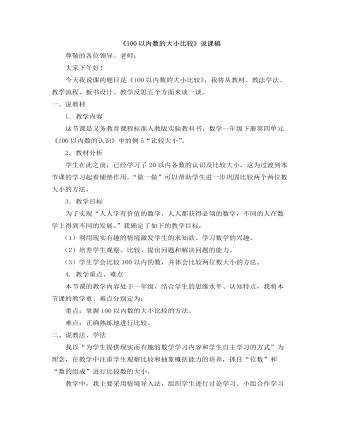
小学数学人教版一年级下册《100以内数的大小比较》说课稿
尊敬的各位领导、老师:大家下午好!今天我说课的题目是《100以内数的大小比较》,我将从教材、教法学法、教学流程、板书设计、教学反思五个方面来谈一谈。一、说教材1.教学内容这节课是义务教育课程标准人教版实验教科书,数学一年级下册第四单元《100以内数的认识》中的例5“比较大小”。2.教材分析学生在此之前,已经学习了20以内各数的认识及比较大小,这为过渡到本节课的学习起着铺垫作用,“做一做”可以帮助学生进一步巩固比较两个两位数大小的方法。3.教学目标为了实现“人人学有价值的数学,人人都获得必须的数学,不同的人在数学上得到不同的发展。”我确定了如下的教学目标:(1)利用现实有趣的情境激发学生的求知欲、学习数学的兴趣。(2)培养学生观察、比较、提出问题和解决问题的能力。
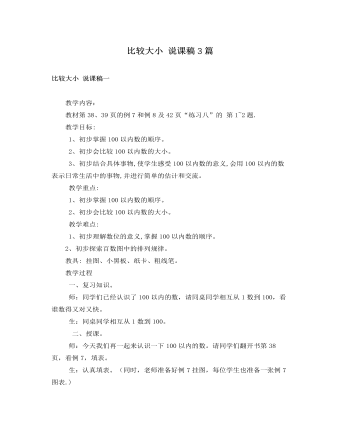
人教版新课标小学数学一年级下册比较大小 说课稿3篇
我说的第二个内容是:比较大小。这节内容的编写意图是先让学生利用实物的多少比较相应数的大小,在利用计数器比较所表示数的大小,接着在直接比较数的大小。以上过程体现了儿童从具体到抽象的认知特点,便于学生掌握比较两个数大小的一般方法。另外,教材提供了充分的并且贴近学生生活实际的教学资源,我们应尽量利用好它,并积极地动手制作学具,以便提高教学效果。以下是教学流程及说明。第一大环节出示例8鸡蛋图,观察比较。这幅图的情景非常贴近农村孩子的生活,学生一看就会感到很亲切,教师可以用兴奋的语言介绍画面,使画面生动起来,同时也明确了学习任务,比如可以这样说:“明明家养了两只母鸡,小鸡下蛋了,明明真高兴,他每天都帮着妈妈捡鸡蛋,而且明明是个细心的孩子,他把两只鸡下的蛋放在各自的盘里,让两只鸡比比赛,看谁下得蛋多。小朋友,你们知道哪只鸡下的蛋多吗?我们快来数一数吧!
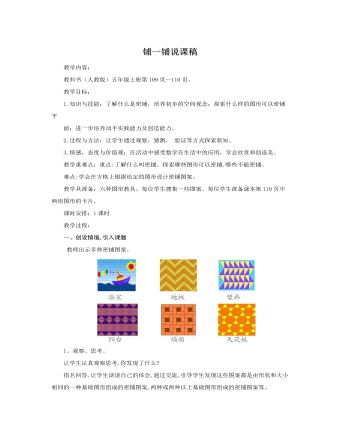
人教版新课标小学数学五年级上册铺一铺说课稿
密铺的历史背景1619年——数学家奇柏(J.Kepler)第一个利用正多边形铺嵌平面。1891年——苏联物理学家弗德洛夫(E.S.Fedorov)发现了十七种不同的铺砌平面的对称图案。 1924年——数学家波利亚(Polya)和尼格利(Nigeli)重新发现这个事实。最富趣味的是荷兰艺术家埃舍尔(M.C. Escher)与密铺。M.C. Escher于1898年生于荷兰。他到西班牙旅行参观时,对一种名为阿罕伯拉宫(Alhambra)的建筑有很深刻的印象,这是一种十三世纪皇宫建筑物,其墙身、地板和天花板由摩尔人建造,而且铺上了种类繁多、美轮美奂的马赛克图案。Escher 用数日复制了这些图案,并得到启发,创造了各种并不局限于几何图形的密铺图案,这些图案包括鱼、青蛙、狗、人、蜥蜴,甚至是他凭空想像的物体。他创造的艺术作品,结合了数学与艺术,给人留下深刻印象,更让人对数学产生另一种看法。
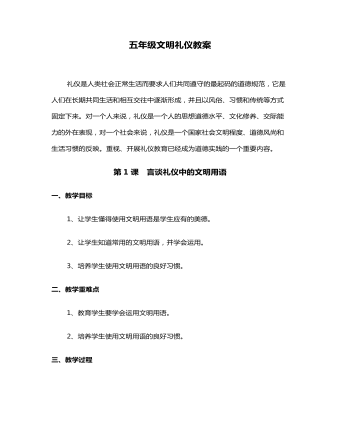
五年级礼仪课教学教材教案
一、教学目标1、让学生懂得使用文明用语是学生应有的美德。2、让学生知道常用的文明用语,并学会运用。3、培养学生使用文明用语的良好习惯。
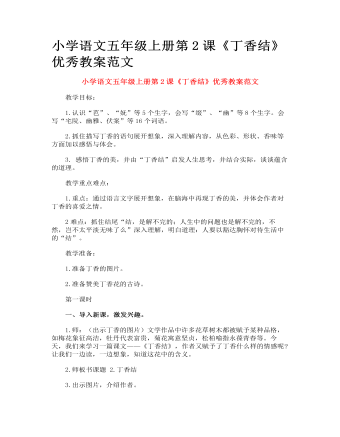
小学语文五年级上册第2课《丁香结》优秀教案范文
初读课文,学习字词。 1.出示自学提示:默读课文,一边读一边画出不认识的字和不理解的词,并借助词典等学习工具书理解。 2.教师检查学生学习情况。 (1)检查生字读音。 ①参差( cēncī)芭蕉(bā)衣襟( jīn)妩媚(wǔ) ②“薄”是一个多音字,在字典中有三个读音,一个读bo,当“迫近、靠近”讲,组词是日薄西山;还有的当“轻微、少”、“不强壮”、“不厚道”、“看不起”等意思,组词是“广种薄收”、“单薄”、“轻薄”、“厚古薄今”等;一个读bo,组词是薄荷,多年生草本植物;还有一个读音是bao,表示感情冷淡、不浓、不肥沃等意思。课文中 (2)指导易混淆的字。 “幽”是半包围结构,外面是“山”,里面是两个“幺”。 “案”是上下结构,上面是“安”,下面是“木”。 “薄”要与“簿”相互比较,可以通过组词的形式来辨析,“薄”组词是“薄饼”,“簿”组词是练习簿。 “糊”:左右结构,与“米”有关,形容非常黏稠、混沌不清的状态。
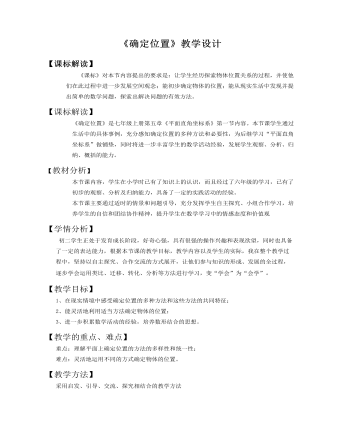
初中数学鲁教版七年级上册《第五章 位置与坐标 1 确定位置》教学设计教案
1、通过同位之间互说座位位置,检测知识目标2、3的达成效果。2、通过导学案上的探究一,检测知识目标2、3的达成效果。 3、通过探究二,检测知识目标1、3的达成效果。 4、通过课堂反馈,检测总体教学目标的达成效果。本节课遵循分层施教的原则,以适应不同学生的发展与提高,针对学生回答问题本着多鼓励、少批评的原则,具体从以下几方面进行评价:1、通过学生独立思考、参与小组交流和班级集体展示,教师课堂观察学生的表现,了解学生对知识的理解和掌握情况。教师进行适时的反应评价,同时促进学生的自评与互评。2、通过设计课堂互说座位、探究一、二及达标检测题,检测学习目标达成情况,同时有利于学生完成对自己的评价。3.通过课后作业,了解学生对本课时知识的掌握情况,同时又能检测学生分析解决问题的方法和思路,完成教学反馈评价。
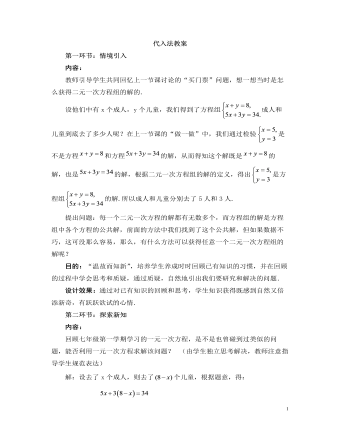
北师大初中数学八年级上册代入法2教案
第五环节:课堂小结内容:师生相互交流总结解二元一次方程组的基本思路是“消元”,即把“二元”变为“一元”; 解二元一次方程组的第一种解法——代入消元法,其主要步骤是:将其中的一个方程中的某个未知数用含有另一个未知数的代数式表示出来,并代入另一个方程中,从而消去一个未知数,化二元一次方程组为一元一次方程.解这个一元一次方程,便可得到一个未知数的值,再将所求未知数的值代入变形后的方程,便求出了一对未知数的值.即求得了方程组的解.目的:鼓励学生通过本节课的学习,谈谈自己的收获与感受,加深对 “温故而知新” 的体会,知道“学而时习之”.设计效果:学生能够在课堂上畅所欲言,并通过自己的归纳总结,进一步巩固了所学知识.第六环节:布置作业课本习题5.2教学设计反思1.引入自然.二元一次方程组的解法是学习二元一次方程组的重要内容.教材通过上一小节的实际问题,比较一元一次方程的列法和解法,从而自然引入二元一次方程组的代入消元解法.
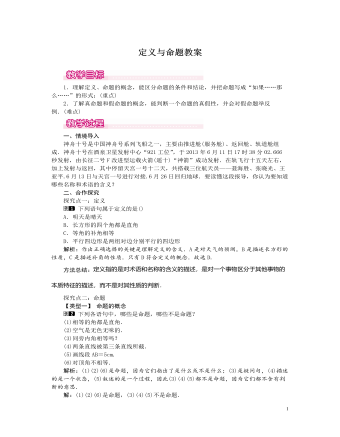
北师大初中数学八年级上册定义与命题1教案
一、情境导入神舟十号是中国神舟号系列飞船之一,主要由推进舱(服务舱)、返回舱、轨道舱组成.神舟十号在酒泉卫星发射中心“921工位”,于2013年6月11日17时38分02.666秒发射,由长征二号F改进型运载火箭(遥十)“神箭”成功发射.在轨飞行十五天左右,加上发射与返回,其中停留天宫一号十二天,共搭载三位航天员——聂海胜、张晓光、王亚平.6月13日与天宫一号进行对接.6月26日回归地球.要读懂这段报导,你认为要知道哪些名称和术语的含义?二、合作探究探究点一:定义 下列语句属于定义的是()A.明天是晴天B.长方形的四个角都是直角C.等角的补角相等D.平行四边形是两组对边分别平行的四边形解析:作出正确选择的关键是理解定义的含义.A是对天气的预测,B是描述长方形的性质,C是描述补角的性质.只有D符合定义的概念.故选D.方法总结:定义指的是对术语和名称的含义的描述,是对一个事物区分于其他事物的本质特征的描述,而不是对其性质的判断.
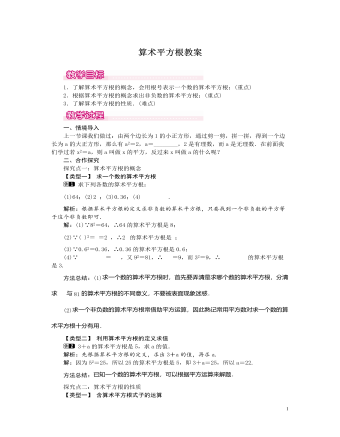
北师大初中数学八年级上册算术平方根教案
一、情境导入上一节课我们做过:由两个边长为1的小正方形,通过剪一剪,拼一拼,得到一个边长为a的大正方形,那么有a2=2,a=________,2是有理数,而a是无理数.在前面我们学过若x2=a,则a叫做x的平方,反过来x叫做a的什么呢?二、合作探究探究点一:算术平方根的概念【类型一】 求一个数的算术平方根求下列各数的算术平方根:(1)64;(2)214;(3)0.36;(4)412-402.解析:根据算术平方根的定义求非负数的算术平方根,只要找到一个非负数的平方等于这个非负数即可.解:(1)∵82=64,∴64的算术平方根是8;(2)∵(32)2=94=214,∴214的算术平方根是32;(3)∵0.62=0.36,∴0.36的算术平方根是0.6;(4)∵412-402=81,又92=81,∴81=9,而32=9,∴412-402的算术平方根是3.方法总结:(1)求一个数的算术平方根时,首先要弄清是求哪个数的算术平方根,分清求81与81的算术平方根的不同意义,不要被表面现象迷惑.(2)求一个非负数的算术平方根常借助平方运算,因此熟记常用平方数对求一个数的算术平方根十分有用.
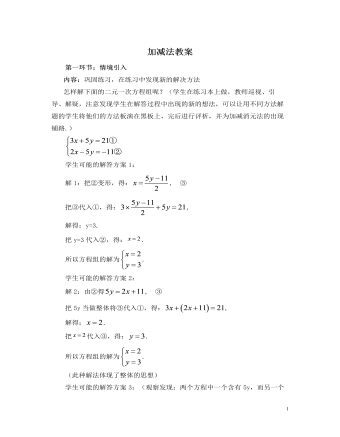
北师大初中数学八年级上册加减法2教案
2.法解二元一次方程组,是提升学生求解二元一次方程的基本技能课,在例题的设置上充分体现化归思想.2.在学习二元一次方程组的解法中,关键是领会其本质思想——消元,体会“化未知为已知”的化归思想.因而在教学过程中教师通过对问题的创设,鼓励学生去观察方程的特点,在过手训练中提高学生的解答正确率和表达规范性,提升学生学会数学的信心,激发学习数学的兴趣.3.通过精心设计的问题,引导学生在已有知识的基础上,自己比较、分析得出二元一次方程组的解法,在巩固训练活动中,加深学生对“化未知为已知”的化归思想的理解.特别是如何由代入消元法到加减消元法,过渡自然。让学生深刻的体会到二元一次方程是一元一次方程的拓展,二元一次方程组又要通过“消元”,转化为一元一次方程求解,这样的转化,不仅有助于学生掌握知识、技能和方法,提高学习效率,而且还加深了对数学中通性和通法的认识,体会学习数学和研究数学的规律,提升数学思维能力.

